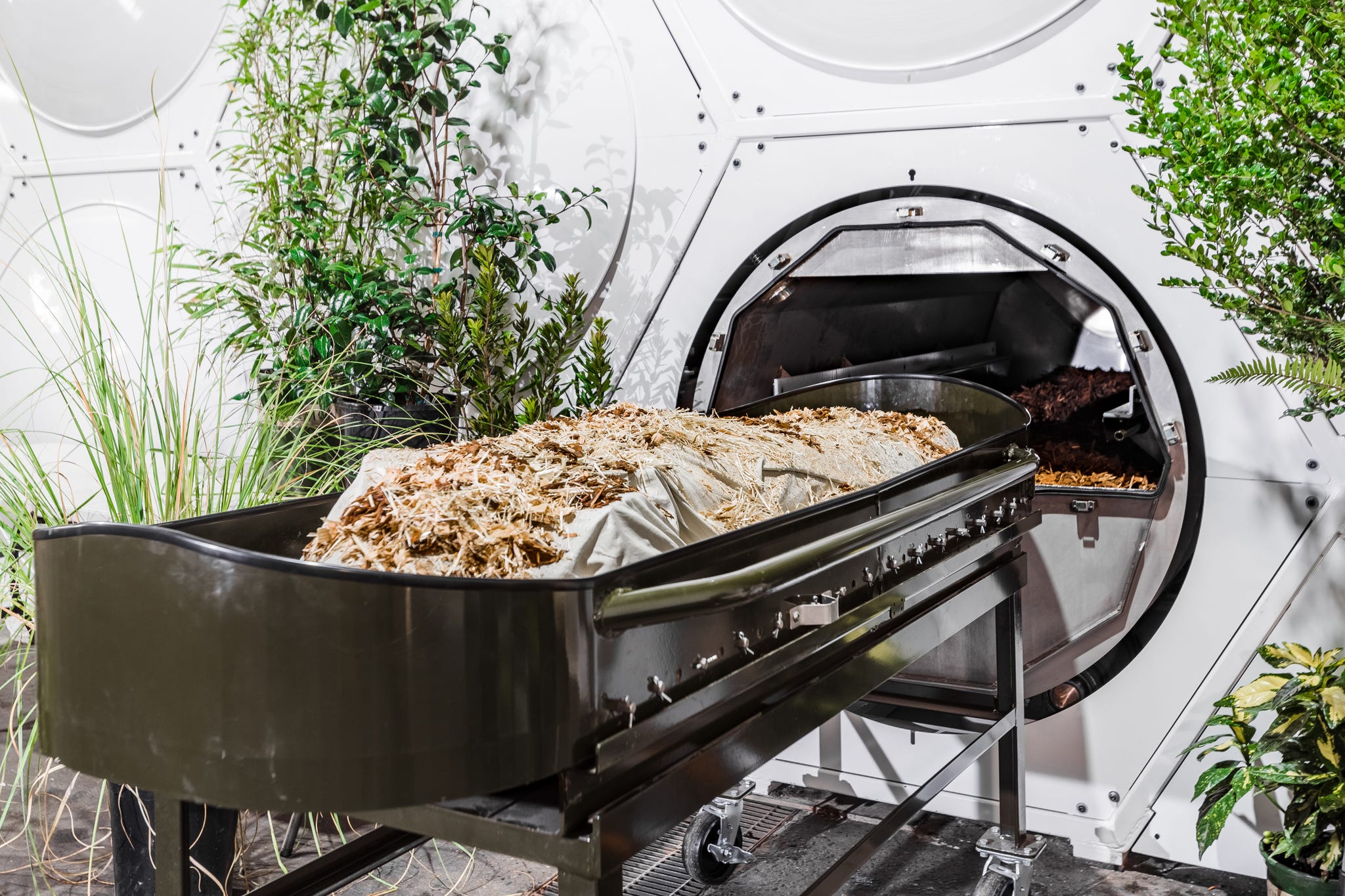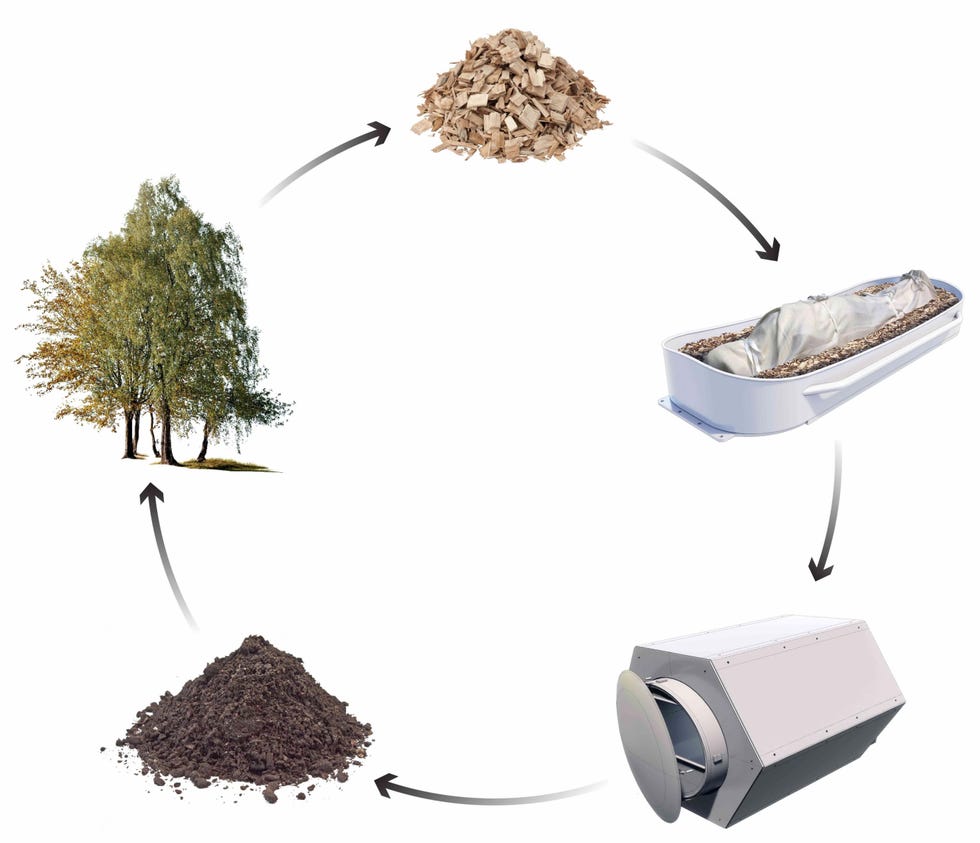
After You Die, This Is the Ultimate Way to Give Your Body Back to Nature
The process of grinding up your bones in a “cremulator” may sound grisly, but it’s quickly gaining traction in the death market.BY CAROLINE DELBERT
PUBLISHED: MAR 15, 2024
www.popularmechanics.com
In the United States, the way we think about death has rapidly changed. The U.S. National Funeral Directors Association reports that a majority of Americans who died in 2023 were cremated. Sixty percent of those making death arrangements were interested in “green funeral options,” up from 55.7 percent since 2021. And some of those people are opting for human composting, or natural organic reduction. It doesn’t require high heat generation, it doesn’t take up space like a traditional burial, and it creates a natural source of plant nutrition. It’s a way to truly return to the earth.
Breaking Down a Body
In a human composting center, workers place a body into a contained ecosystem along with natural bedding like mulch and hay, and periodically tend to each habitat (similar to how you rotate your compost.) The process that Katrina Spade helped to design at her company, Recompose, is modeled on one used to compost dead livestock; in testing, she hired a soil scientist to ensure that the heat of the composting process was enough to kill any pathogens. This happens in plant and animal composting, too.At a similar company, Return Home, the process digests the soft tissues of the body into nutrients in the soil. Then the bones and any medical devices can be removed, and the latter are recycled. The company uses a cremulator, a traditional cremation tool, to grind bones into pieces. Like a coffee grinder or blender, the cremulator’s rotating blades turn larger pieces into smaller ones. The resulting finer particulate of bone is ideal for composting.

A posed dummy in a Recompose Cradle, made ready for the composting process.
Today’s Burial Problems
Today, people interested in burial have a lot of choices. That’s partly because strict laws and taboos around burying people outside of cemeteries or other designated places are changing. A majority of states allow burial on private property, some with caveats.Embalming is not required across the board. Even the required depth of burial varies a lot, and some states don’t have a depth requirement.
For some people, allowing unembalmed burial on private land isn’t enough. Many people will never own land in a rural enough place to comfortably bury a loved one. Cemeteries have been running out of space for a while, and experts say fewer people want the traditional American ceremonies linked with death, like viewings and services at funeral homes and churches. But that doesn’t mean people don’t want their death to bring closure, a sense of ritual, or a meaningful return to the earth.
Cities have long had unique challenges with human burial because of their population density. Neighborhoods might eventually surround cemeteries on the edge of town by the time they need to expand. Our parklike modern cemeteries date back to just Victorian times, when they were boosted as part of an overall public park movement in the U.K. Brooklyn’s iconic Green-Wood Cemetery started as a public park. But while taxes fund parks, cemeteries are often privately owned. When they stop having open spaces to sell, they start losing income. It grows ethically murky very fast.
This is where human composting enters the scene. As a graduate student, Spade first introduced the idea in her architecture thesis in 2013, The Verge reports. She wondered if people in cities might plan to send their dead bodies to clean, organized spaces where caretakers could use nature’s own processes to speed up decomposition—or “recomposition,” as she calls it. This results in an amount of enriched soil, because the human body is full of nutrients like nitrogen, potassium, and phosphate that plants need.
It works a lot like any other composting system, or wild life cycle, such as a decomposing log or whale fall—when dead whales sink and become an instant food source for other creatures. Natural topsoil called humus hosts organisms whose place in the ecosystem is to digest animal and plant matter into soil, like earthworms on the larger end and microbes and tiny insects on the smaller end. Together, they form a food web, with each organism playing a part, like digesting a particular nutrient or a particular size of particle.

Olson Kundig for Recompose
The cycle of body composting helps to provide nutrient-rich soil for the ecosystem, which in turn provides natural material for the human composting process.
The Pitfalls of Cremation
“Death market” figures show the overall rise in cremation rates during the COVID-19 pandemic. Cremation results in a small, tangible object that can be buried anytime, without the countdown to decay that even embalming can’t stop. For decades, it’s been growing in popularity as a more environmental and space-saving way to prepare bodies after death.But that’s not the end of the story. Traditional cremation requires temperatures of 1,400–1,600 Fahrenheit, the Cremation Association of North America explains. The type of ashes we imagine—where what is left is fine powder with some small shards of bone—is just not possible with a wood fire. It’s possible with coal or maybe an accelerant, but at that point, the environmental catch-22 is pretty evident. Traditional cremation is better at saving space than it is at saving the planet—and saving space has had enormous value around the world for thousands of years.
The Financial Times estimates that each traditional cremation in the U.K. in 2018 cost about 150 kilograms of carbon dioxide; that’s 25 percent more than a one-way flight from Boston to Paris. Traditional funerals cost many thousands of dollars on average, and burying embalmed human bodies in airtight containers has never been an environmentally friendly project to begin with.
If you’re thinking about your future, there are more options than ever.
So You Want to Be Composted. Keep These Points in Mind:
At Return Home, the “essentials” package costs about $5,000, with an additional $500 for an in-person or webcast farewell ceremony. At Recompose, the composting service is $7,000, with options for farewell services from $900 up to $1,700. The National Funeral Directors Association reports the median cost of a traditional funeral in 2023 was $7,848, while a traditional cremation funeral has a median cost of $6,970. (Remember that median is not average. The top 50 percent of funerals can cost any amount higher, including those for celebrities or royalty.)
There’s also one wrinkle if you want your body to be composted after your death: bodies cannot be embalmed before the process starts. The chemicals used in the funeral industry are “not compatible with” the natural decomposition process, Recompose explains, and many are carcinogenic or otherwise toxic. They aren’t safe to mix into soil that people will take home and use in their yards. If you die while traveling, you will typically be embalmed before you’re transported home.
The Ethical Dilemma
There’s an interesting split over human composting, particularly evident in Christianity. The Verge’s 2022 article about Return Home leads with an anecdote about Sharon, a woman who had died from complications of multiple sclerosis. She was also a Mormon. True-blue Christians hew to an idea called stewardship, which is the way humankind must care for the earth and environment as cornerstones of God’s creation.And today, that often includes climate change. A majority of U.S. Christians believe climate change is happening, and that it’s a serious problem. Taboos about burial did not stop Sharon, and perhaps won’t stop others who don’t take the resurrection of the body literally. But the Catholic Church in the U.S. has declared both human composting and water cremation off-limits for Catholics, saying they violate “human dignity” and Catholic teachings about the hope of resurrection. The Catholic Church also says cremation is only allowed if the remains are “laid to rest in a sacred place,” not kept or scattered.
Your reaction to the details above might be a good litmus test for how you feel about human composting. To many people, even those who are Christians, the body is the vessel for what really makes human beings special, and there’s a good argument for human composting. God told Adam, “For dust thou art, and unto dust shalt thou return.” God told Adam to eat plants and bread while he lived, implying that humanity and its foods all grew from and nourished the same earth together. So, perhaps it could be viewed as a special honor, and something sacred, to share your resources for future generations to use.
But if you think it sounds disgusting, and to even think about it is macabre—that’s valid! The vast majority of Americans are still choosing traditional burial or cremation.
Today, human composting is legal in California, Colorado, Nevada, New York, Oregon, Vermont, and Washington, states representing about 24 percent of the U.S. population combined. Legislation is in process in many more states.
Caroline Delbert is a writer, avid reader, and contributing editor at Pop Mech. She's also an enthusiast of just about everything. Her favorite topics include nuclear energy, cosmology, math of everyday things, and the philosophy of it all.
